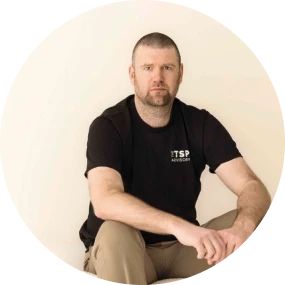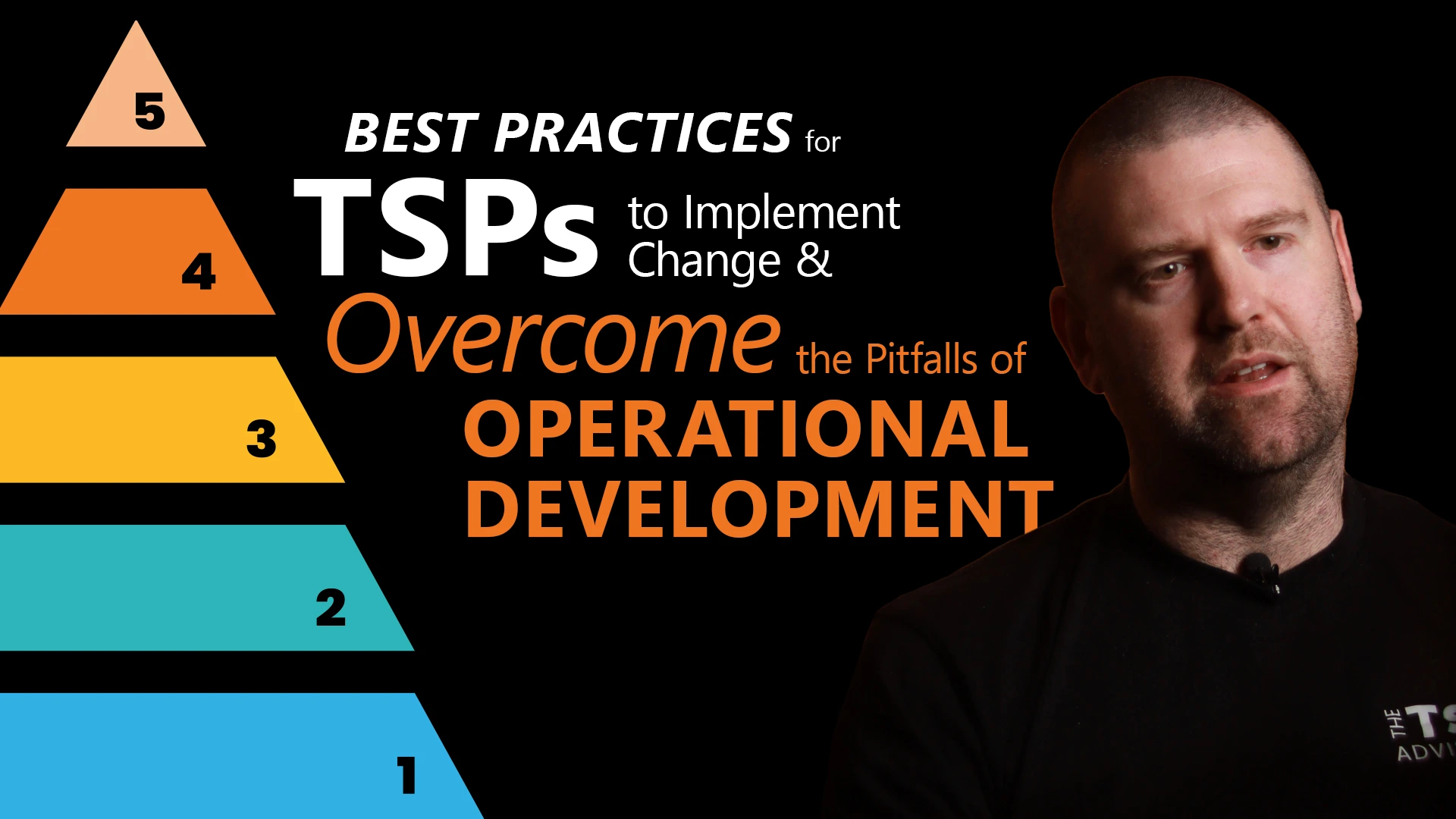Episode Summary
Hear from James Davis, the Chief Strategy Officer of The TSP Advisory as he takes us through the 6 Stages of Operational Maturity for a Technology Solutions Partner and what to expect at each stage, this system can also be applied to understanding our clients and ensure that we are always one step ahead of them.
Transcript
James: So when we're thinking about operational maturity for a technology solutions partner, it's something that's often seen as subjective. We just sort of feel like we're mature or we're not. We don't often know where we match up to standards. And to be honest, there hasn't been that many places that have defined the standards of operational maturity for a technology business.
I created a system, a framework, which is the six stages of operational maturity for a technology solutions partner, which I'll take you through. And the idea is we can understand where we're at through objective measures and understanding the practices that we undertake now and what good looks like as we go up the scale of operational maturity.
The six stages are broken down into levels. There's stage 0, 1, 2, 3, 4 and 5.
The names of them are, I call them at stage 0 - We're just 'starting'. That's where we have no processes. We don't quite know what we're doing. Decisions aren't made by data. We're having to reinvent the wheel or basically start everything from scratch every time we're doing something because we haven't fully formed our practices in our business as of yet.
Stage one, as we transition into that and often this is just a time thing is we start to become 'forming'. We're starting to form all of our practices. A lot of this means that we've got informal practices that we run and what that means is it's in our heads. We know how to do a certain thing. We make decisions a certain way based on these certain outcomes in our history. But it's not a repeatable methodology around it. It's requiring the owner that has everything in the head to make all these micro decisions all the time.
Stage two, we're 'developing'. We're developing our practices. So we're getting those things that are inside our head and actually putting them down on paper. We're starting to document workflow, we're creating SOPs and we're starting to make it repeatable. We start to implement some metrics at that point. Those metrics are often just pass or fail. Did we do it or didn't we do it? It's very binary. We're not getting into that detailed measure. But we're still leading those practices from the owner making decisions saying what's right and what's wrong.
Stage three, we're starting to 'solidify' - where we've got a lot of these practices documented. It might not be perfect, but it's there from our stage two. And we're starting to drive it through our leadership team. They're the ones that are starting to own practice areas in the business. They are owning those processes and they're running it through their teams. Now metrics start to become a lot more detailed around these processes and practices, and the roles and responsibilities are starting to become important because no longer is it just the owner making all the decisions for everyone. All of a sudden people are needing to make more decisions as a leadership team. So that clarity of people's responsibilities come to play.
Stage four, we're really starting to embed our practices. We're in that 'embedding' stage. Processes are now measurable, a lot more end to end. There's staff KPIs down to the frontline layer, and we're starting to make data-driven decisions at the leadership level because we've got the practices in place to enable that.
Then finally, we get to stage five where we're 'living' it. We're living our practices. We've got a continual improvement culture because we've got well established foundations in place. People know what they own and they're responsible for. We've got measurements. We've got accountability in place that we can start to drive new initiatives to improve efficiencies, drive productivity, streamline things, all driven by the leadership layer.
And as you can see, there's sort of a journey that we go on through these stages. But most of us don't often get past that sort of stage two level because we don't know what good looks like. We've organically grown our businesses from not knowing anything. We probably pick some stuff up when we've gone to community and industry events and we've hodgepodged our way to having a fairly stable business with some documentation in place. But the owner is still one that's really owning it because they haven't been able to transition that into the deeper detailed metrics the aligning the roles and responsibilities with clarity that delegation and then driving that continual improvement progress. So there's that real tipping point there that we need to understand. And that's been part of the reason why I've developed this framework and there's a lot of nuance under it and as we lift the covers from that high level perspective that I've got what you can start applying this to and what I do apply this to is all your functional areas of the business - across sales, across service delivery, projects, HR, finance, procurement etc. - these maturity models and start applying the operational functionality level where you can then measure your maturity in each area to then start to help you focus on what initiatives that you need to improve, what functional areas need the most attention to mature without just relying on that traditional way of doing it of the growth pains, the area that's got the most fires, the areas that cause the most complaints - we're very reactive to it. We can start them planning our transformation program over years to improve our practices and it's key to understand that what I just said if it takes years I would typically say for most people it takes three to five years to go from one stage to another if you look at the really well established businesses, they've been around for a very long time because they've had to go on a deliberate journey. If you don't know and you've started as an owner in a technology services business and you're having to learn everything while implementing it, it's going to take time to develop that cultural DNA.
The only ways you can fast track this is if you've been there and done it before if you've got a leadership team that's highly experienced. You can go from starting and immediately implement straight to developing or solidifying. It's unlikely that you're to go from say 0 to 5. You're going to have to go through some stages, but you can skip some steps if you've got the people in the culture that are already at that level. Whereas most of us are trying to aim to go from 0 to 5 and that's where we hit hurdles. If you think about the way that you've tried to implement a PSA before, if you've thought about the ways that you've tried to implement account management practices, you hear what maybe good looks like in the industry if I pick on account management and we're implementing QBRs, our quarterly business reviews, everyone gets stuck as they're trying to over-engineer this perfect system because that's what you've seen what good looks like.
But we're not even got a regime of going and talking to our clients in the first place. We're trying to go from zero to five. There's so many transformation steps that need to occur to build the body of knowledge, to build the rhythms, to build the culture, to actually operate at that maturity level. So understanding where you are and what's next is actually far more important than actually understanding what pure utopia is because that pragmatic step-by-step nature of this framework is what helps people progress. And that's the important thing that continual improvement and maturity over going from zero to five, because there's so much moving, so many moving parts in our business, so much nuance, so many things to learn and truly appreciate. But actually the maturity maturation journey in itself is actually super critical to our learning, we need to touch and feel things and for us to actually embedded in ourselves and our DNA and our culture. So something to think about, there's heaps of nuance, I could go on for hours and hours around this but hopefully this has been enough to give you a good understanding - a starting point to realise what the maturity levels are, maybe where you just sit in general and I'll produce a whole lot more content in the future to break this down into more tangible bite-sized pieces, but I'll be using this framework to allow people to understand where I'm talking about and what and how I'm talking about it.

Chief Strategy Officer,
The TSP Advisory

Subscribe for more
Subscribe to our resources to make sure you're in the know and for tools to enable your transformation.
